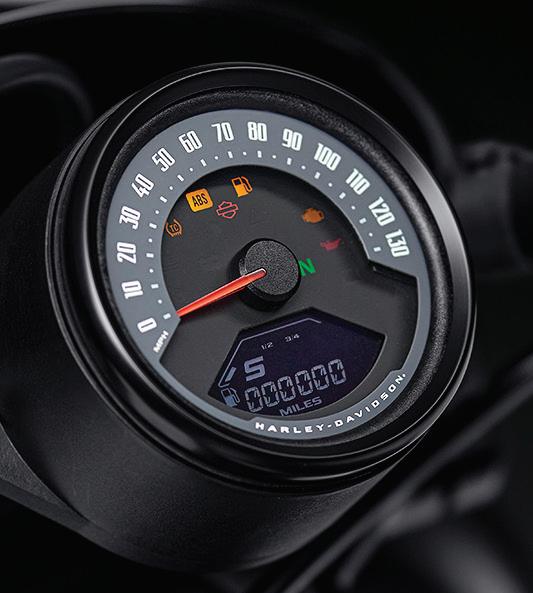
2 minute read
2023 NIGHTSTER
Rated at 90 horsepower at 7500 rpm, the 975cc engine really is a joy — it’s wonderfully torquey and a willing revver; it’s also relatively vibration-free and, thanks to variable valve timing and a 6-speed gearbox, flexible in any riding condition, from slogging through stop-andgo traffic to strafing apexes in the twisties, to freeway flying. (Unfortunately, we found the gearbox operation compromised by stiff shift action.) The engine turns a lazy 3200 rpm at an indicated 60 mph.
In keeping with the times, standard tech features aboard the Nightster include ride-by-wire throttle control, which enables the inclusion of three power modes (Road, Sport and Rain) that can be selected on the run. Noticeably distinct from one another, each power mode tailors throttle sensitivity and power output, how aggressively the standard traction control intervenes, and the amount of engine braking that occurs when you roll off the throttle. ABS is also included as standard equipment.
Interestingly, the Nightster has no traditional frame; instead, front, mid and rear sections bolt directly to the engine, which is thus a fully stressed chassis member. In case you have any qualms about this, Ducati uses the same concept on its Superleggera V4 superbike. The steering geometry (for data geeks, this includes 30º steering rake, 5.4 inches of trail ahead of a 61.3-inch wheelbase) is relaxed, and wheels and Dunlop tires are traditional Sportster fare – 19 inches in front and 16 inches out back. As such, handling is linear, steady and predictable. Even so, know that in expert hands the Nightster can still throw-down on a curvy road.
In terms of ergonomics, the Nightster follows traditional Sportster forms once again, with a low solo seat (27.1 inches high, says the Motor Company, with a 180-pound rider aboard), and low, mid-mounted footpegs and controls. If you like this architecture — and legions of riders do — you’ll likely be happy with the Nightster as a regular companion for commuting, exploring, or even touring. Incidentally, the solo seat is incredibly comfortable — a marvel, really.
The heart of the matter here is the Nightster’s delicious Revolution Max V-Twin, which offers 975cc of seamless and torquey motivation, and 90 peak horsepower.
Due mostly to the Sportster-driven triangulation of a low seat (a particular benefit for newer or smaller riders), the amidships footpegs, and a traditional low-rise handlebar, the overall Nightster package does have some limitations. Negatives include only modest suspension travel and average cornering clearance, mostly on the right where the big exhausts live. If you ride fast, you’ll likely feel your right boot getting hot from the exhaust pipe and dragging in turns.
The Revolution Max series was a “clean-sheet” effort designed to take Harley-Davidson into the future, while retaining selected traditional design language. In the case of the new Nightster, this approach brings some victories, some satisfaction — and some compromises, too. Taken as a whole, though, this latest Sportster derivative is a solid and attractive motorcycle that proves Harley’s ability to once again reinvent the Sportster DNA to meet the times — now 65 years on. AMA










